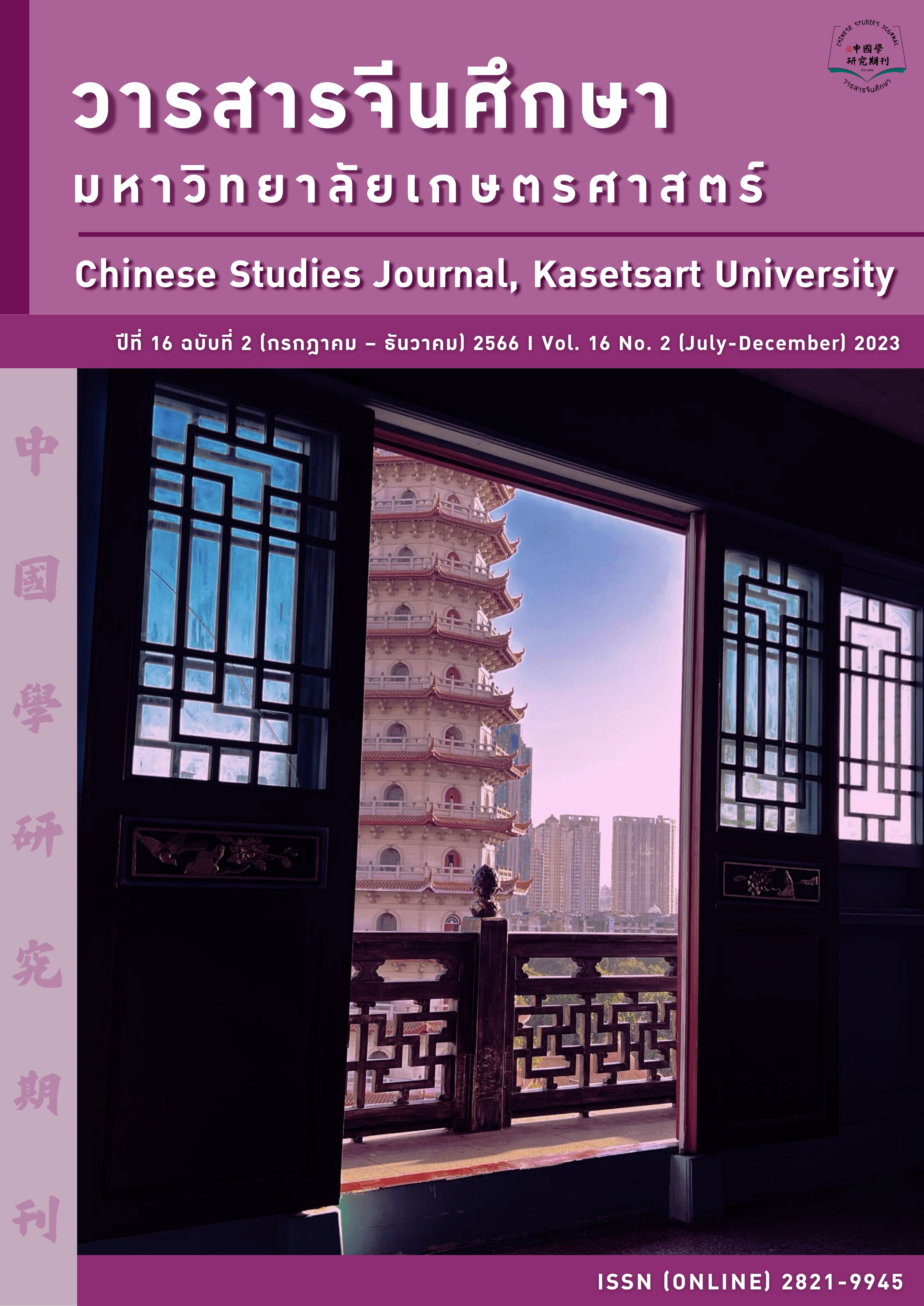Construction of Folklore in the Online Horror Film “Legend of the Xing'an Mountains Hunter” การศึกษาโครงสร้างนิทานพื้นบ้านในภาพยนตร์แนวสยองขวัญเรื่อง “ตำนานนักล่าซิงอันหลิง”
Main Article Content
Abstract
The online horror film “Legend of the Xing’an Mountains Hunter,” released during the COVID-19 pandemic, received critical acclaim and financial success, with its folklore narratives being a major highlight. This paper, utilizing methods such as “literature review,” “organization and summarization,” “comparative analysis,” and "case analysis,” compiles the folklore elements featured in the film. It analyzes the adaptation of folklore in the movie and explores the characteristics of online horror films. The study reveals that the folklore in the film is characterized by being “down-to-earth,” “non-mainstream,” and “diverse,” contributing to attention and discussion the film has received. However, these characteristics also present challenges in film production. The paper analyzes how the film utilizes folklore from a narrative perspective, highlighting the film's narrative strategy of strengthening the connection between each movie story structure based on the three-act-screenplay structure of classic horror film elements. Focusing on the legendary folk element of the "human-faced tree" in the Xing’an Mountains, the film adopts a narrative approach with one observer and multiple narrators, creating a storytelling pattern of “potential storyline and obvious storyline intertwined, truth and lies intersect.” This structure forms vivid narrative imagery with contrasting elements, utilizing abstract, three-dimensional, and regionalized audio-visual language. The film conveys simple folk values such as “A virtuous man makes his fortune in a proper way,” “family wealth should not be flaunted,” and “karma and retribution.” The balance between artistic and commercial aspects has gained favor from audiences and recognition from the industry. It opens up new avenues for the development of online horror films and pioneers a fresh approach to incorporating folklore in horror cinema. It marks a new milestone for the evolution of horror films based on folklore in the online genre.
Article Details

This work is licensed under a Creative Commons Attribution-NonCommercial-NoDerivatives 4.0 International License.
ผลงานทางวิชาการที่ลงตีพิมพ์ในวารสารจีนศึกษา มหาวิทยาลัยเกษตรศาสตร์ เป็นลิขสิทธิ์ของผู้เขียนหรือผู้แปลผลงานนั้น หากนำลงในวารสารจีนศึกษาเป็นครั้งแรก เจ้าของผลงานสามารถนำไปตีพิมพ์ซ้ำในวารสารหรือหนังสืออื่นได้โดยมิต้องแจ้งให้ทราบล่วงหน้า แต่หากผลงานที่ได้รับพิจารณานำลงในวารสารจีนศึกษา เป็นผลงานที่เคยตีพิมพ์ที่อื่นมาก่อนเจ้าของผลงานต้องจัดการเรื่องปัญหาลิขสิทธิ์กับแหล่งพิมพ์แรกเอง หากเกิดปัญหาทางกฎหมาย ถือว่าไม่อยู่ในความรับผิดชอบของวารสารจีนศึกษา มหาวิทยาลัยเกษตรศาสตร์ ทั้งนี้ ความคิดเห็นต่างๆ ในบทความเป็นความคิดเห็นส่วนตัวของผู้เขียน ไม่เกี่ยวกับกองบรรณาธิการวารสารจีนศึกษา มหาวิทยาลัยเกษตรศาสตร์
References
肯德尔•菲利普.(2005).恐惧的投射——美国恐怖电影与美国文化.绿林出版社.
高永旺.(2018).大慈恩寺三藏法师传.中华书局.
冯国超.(2016).增广贤文.商务印书馆.
杨义.(2009).中国叙事学.人民出版社.
包朝鲁孟.(2018).北方少数民族民间传说动画剧本的创作实践.(硕士学位论文,内蒙古师范大学).
洪潇楠.(2014).华语恐怖电影研究.(博士学位论文,吉林大学).
李扬.(2019).网络大电影叙事策略研究.(硕士学位论文,河南大学).
许栩.(2011).电影叙事视角探究(硕士学位论文,云南艺术学院).
盛羽君.(2016).中国恐怖类型电影的历史、文化与传统.大众文艺,(02),207.
管红星.(2009).当前国内恐怖电影研究综述.电影文学,(23),10-11.
陈晓云.(1999).期待视野与视野融合影视欣赏心理散论.电影艺术,(02),82-86.
李天语.(2021).灵异化、丑恶化、卑贱化:欧美恐怖电影审美的三次流变.艺术百家,(03),188-194.
阮世勤.(2012).恐怖背后:论欧美科幻惊悚电影中的怪物形象.湛江师范学院学报,(04),90-93.
张欲晓.(2014).欧美恐怖电影的精神分析.辽宁科技大学学报,(01),92-95.
李陆、王陆.(2019).浅谈中国网络电影产业的变化与发展.记者观察,(36),126.
胡建.(2019).网络大电影的现状与前景太原.文化产业,(07),41-42.
李赞.(2020).新媒体领域下网络电影的叙事特征分析.电影文学,(07),67-69.
杨晓林.(2019).网络大电影的叙事嬗变及制胜之道.人民论坛,(18),128-130.
曾峥.(2018).新媒体环境下网络电影的叙事特征分析.大众文艺,(06),166.
李博轩.(2020).重置•异化•共情:网络大电影《灵魂摆渡•黄泉》创作特征探析.传播力研究,4(20),46-48.
鞠斐、彭勃.(2019).香港僵尸电影与网络灵幻大电影比较研究.新闻研究导刊,10(20),117-118.
徐天雨.(2021).深度有机融合:新时期网络大电影的突围之路.视听界,(04),108-110.
陆佳佳、刘汉文.(2019).2018年中国电影产业发展分析报告.当代电影,(03),13-20.
熊江卫.(2016).试论网络大电影的兴起和特征.视听界(广播电视技术),(02),122-128.
徐亚萍.(2016).网络大电影:转型中的网络电影及其风险.现代传播, 38(12),117-120.
曹开研.(2017).网络大电影特征及发展趋向刍议.传媒,(04),51-53.
吴侠.(2021).《兴安岭猎人传说》的民间故事再演绎.电影文学,(18),119-122.
张兴.(2021).网络大电影的长尾时代与大数据.大众文艺,(17),109-110.
巴丹、薛书凝.(2021).基于网络平台二人转的碎片化传播研究.戏剧文学,(09),20.
张歆.(2021).《一幅僮锦》:一个民间传说的影像建构.电影文学,(03),112-117.
唐芳.(2020).市场转型背景下网络大电影的发展.新闻研究导刊,(21),143-144.
曹炜.(2005).关于汉语隐语的几个问题——兼论隐语与黑话的区别.学术月刊, (4),66-73.
王咏梅.(2012).论叙事意象的审美生成.文艺评论,(05),37-39.
刘轩狄(Director).(2021).兴安岭猎人传说[Film].Tianjin Rabbit Hole Film Culture Media .
豆瓣.(2021).影片《兴安岭猎人传说》评分.豆瓣评分.https://movie.douban.com/subject/35027719/


